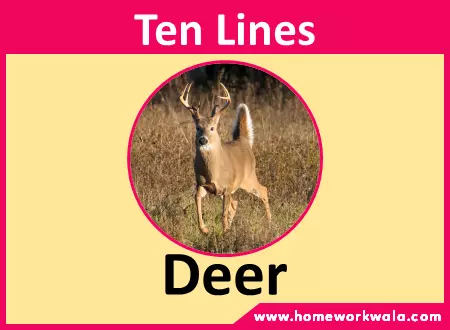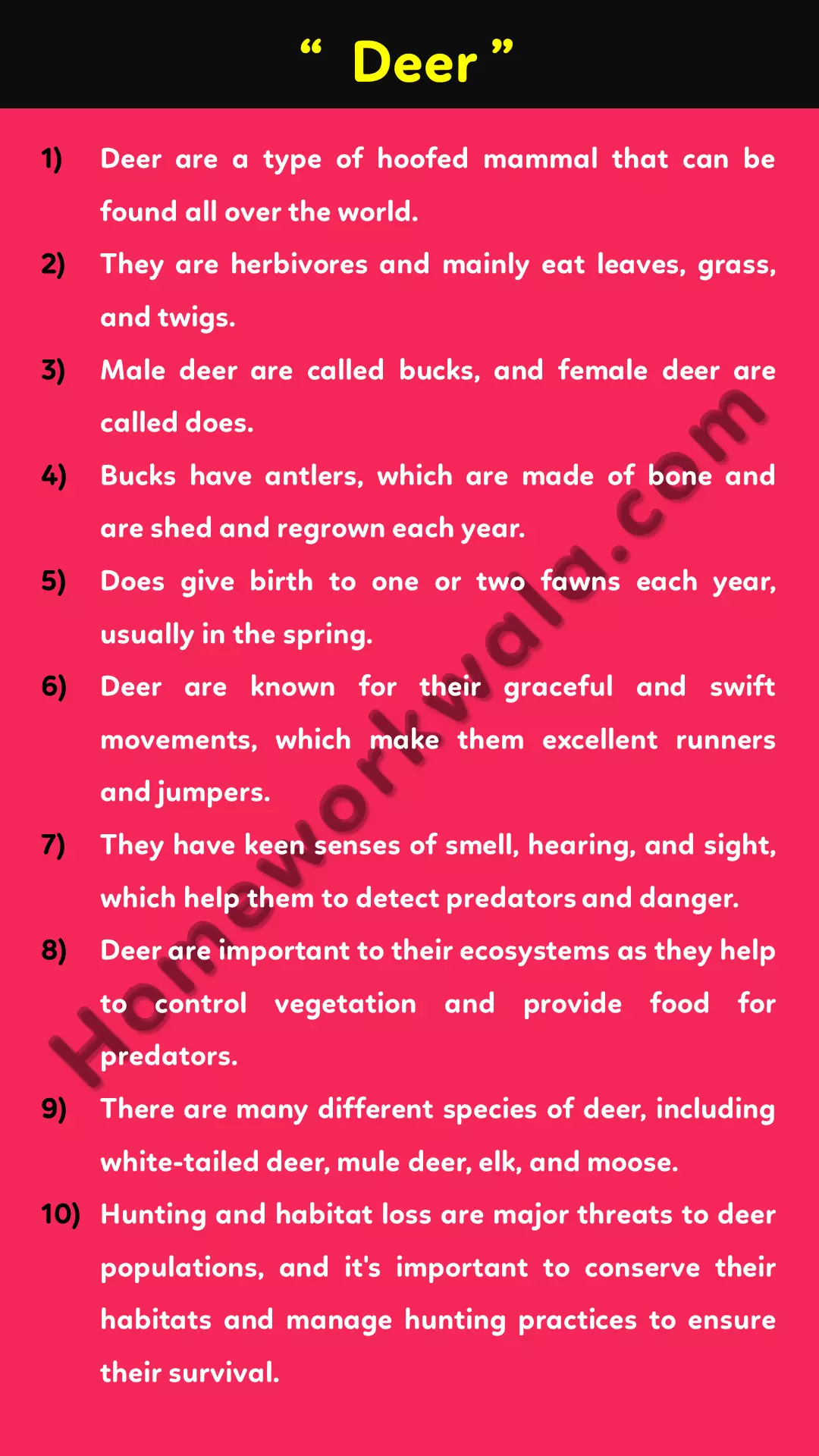Table of Content
Through this article, we are sharing 10 lines on Deer in English. This post will help those students who are looking for information about Deer in the English Language.
If any student wants to write a short essay on Deer then, this post is very useful for them. Information about Deer is very simple and easy for writing purposes.
These sentences on Deer are very short and easy to understand, so any level of student can write on this topic.

Short essay on Deer in English ( In 3 Formats )
Format-1
- Deer are a type of hoofed mammal that can be found all over the world.
- They are herbivores and mainly eat leaves, grass, and twigs.
- Male deer are called bucks, and female deer are called does.
- Bucks have antlers, which are made of bone and are shed and regrown each year.
- Does give birth to one or two fawns each year, usually in the spring.
- Deer are known for their graceful and swift movements, which make them excellent runners and jumpers.
- They have keen senses of smell, hearing, and sight, which help them to detect predators and danger.
- Deer are important to their ecosystems as they help to control vegetation and provide food for predators.
- There are many different species of deer, including white-tailed deer, mule deer, elk, and moose.
- Hunting and habitat loss are major threats to deer populations, and it’s important to conserve their habitats and manage hunting practices to ensure their survival.
You May Also Like
Format-2
- Deer are part of the family Cervidae, which includes elk, moose, and caribou.
- They have a four-chambered stomach that allows them to digest tough, fibrous vegetation.
- Deer are considered crepuscular animals, meaning they are most active during the early morning and late evening hours when the sun is low on the horizon.
- They have a good memory and are able to remember the locations of food sources and safe areas.
- The antlers of male deer are used for fighting during mating season to establish dominance and win mates.
- Deer are excellent swimmers and can swim long distances to escape predators or reach new feeding areas.
- They have a unique behavior called “yarding,” where they gather in large groups during the winter to conserve energy and stay warm.
- Some deer species are migratory, traveling long distances to reach their seasonal habitats.
- Fawns are born with white spots on their fur, which help them blend in with their surroundings and avoid predators.
- Deer have a lifespan of around 6-14 years in the wild, depending on their species and environmental factors.
Format-3
- Deers have a complex social structure and communicate with each other through body language, vocalizations, and scent marking.
- They have a unique adaptation called “rumination,” where they regurgitate and re-chew their food to aid digestion.
- Deer are important prey for many predators, including wolves, cougars, and bears.
- They can run at speeds up to 40 miles per hour and jump over 8 feet high, making them difficult to catch.
- Deer have a natural camouflage that helps them blend in with their surroundings and avoid predators.
- They are able to lower their heart rate to conserve energy during periods of rest or danger.
- Deer are hunted for their meat, hides, and antlers, which are used for a variety of purposes.
- The mating season for deer varies by species but typically occurs in the fall and early winter.
- Deer are able to survive in a variety of habitats, including forests, grasslands, and wetlands.
- There are over 90 species of deer, ranging from small, forest-dwelling species to large, migratory species.

FAQ
- What is a deer?
- What do deer eat?
- How long do deer live?
- What are the different species of deer?
- How do deer communicate with each other?
- What are antlers used for?
- Are deer dangerous?
- What is yarding?
- What is a fawn?
- What are the threats to deer populations?
Deer are a type of hoofed mammal that is found all over the world.
Deer are herbivores and mainly eat leaves, grass, and twigs.
The lifespan of deer varies depending on their species and environmental factors but typically ranges from 6 to 14 years in the wild.
There are over 90 species of deer, including white-tailed deer, mule deer, elk, and moose.
Deers communicate with each other through body language, vocalizations, and scent marking.
Antlers are primarily used by male deer for fighting during the mating season to establish dominance and win mates.
Deer are generally not dangerous to humans but can become aggressive if they feel threatened or cornered.
Yarding is a behavior exhibited by some deer species, where they gather in large groups during the winter to conserve energy and stay warm.
A fawn is a baby deer, usually born in the spring.
Hunting and habitat loss are major threats to deer populations, and it’s important to conserve their habitats and manage hunting practices to ensure their survival.
We hope! You will get some learning through this article. If you really like this article about Deer in English, then please share it with your friends.
We working on helping the students to do their homework in a simple and easy way. Essay writing on Deer is generally asked the students in Schools.